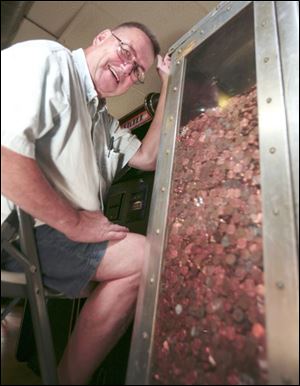
Penny saved is a penny earned - and coin hoarders keeping U.S. mint busy
9/11/2007There's no "penny candy" anymore. The term penny arcade is a misnomer. Gum-ball machines that decades ago took pennies have long since graduated to nickels, then quarters.
So, what's a penny good for these days? By itself, a one-cent piece surely isn't worth much - they actually cost about 1.7 cents each to manufacture, according to the U.S. Mint. Some economists and lawmakers believe we'd be better off without the penny or that pennies should be made of cheaper metal than zinc and copper.
But a whole bunch of pennies, now that's a different story.
Toledoan Ted Grandowicz has an estimated 400,000 of them, weighing 2,700 pounds or so, encased in a bank made of stainless steel and bullet-proof glass. The longtime tavern owner said the collection represents a future contribution toward the college education of two grandchildren, now 15 and 13.
He is one of many people who hoard coins for a variety of reasons, and perhaps they're part of the reason the Mint has to keep producing coins. The Mint makes about 8 billion pennies a year and there are an estimated 140 billion pennies in circulation.
It's not just pennies, either. Folks hoard coins of all sorts.

Ted Grandowicz figures he has about 400,000 pennies in a steel and bullet-proof glass bank he built.
For example, Delton Opfer, a retired ironworker in East Toledo, said he saved coins of all denominations until he filled a five-gallon jar. He finally cashed in the $5,200 worth of coins to finance a new truck cab and a golfing trip to North Carolina.
Orphie Campolongo, of Lake Township, said she saves all of her and her husband's spare change in a in tin box, and just before her annual trip to Las Vegas, she takes rolls of the coins to her bank to stockpile for her gambling. "It's usually about $500," she said.
Mr. Grandowicz, a retired railroader, still has a way to go to catch up to such over-achievers as Lynn
Wagner, a central Pennsylvania resident who amassed 1 million pennies by 2003. According to news reports, it took Mr. Wagner several months to convert his $10,000 worth of pennies into folding money by hauling them to a bank buckets at a time.
About 20 years ago, Mr. Grandowicz, then owner of Scotty's Cafe, on Bush Street in North Toledo, started putting pennies into a jar. "It was a pain to take them to the bank," he explained.
After a few years, the collection grew in size and filled a large jar that had been used for bottled water in an office building. Ten years ago, a longtime customer constructed the "bank," which is 4 feet high, 18 inches wide, and 18 inches deep.
He doesn't know for sure how much money is in the container. Although it's mostly pennies, there are some other coins, and some customers also put in bills they signed.
The "bank" sits in his former tavern, which he sold several years ago and is now known as Tim & Ed's Bar & Grill.
It's now nearly three-fourths full, and if it fills up, there could be nearly 600,000 pennies, or about $6,000 in it. Then comes the hard work - the bank will have to be busted apart, the coins collected and probably washed, and cashed in.
Whatever is collected, "it probably will be enough to pay for [college] books," said Mr. Grandowicz philosophically.